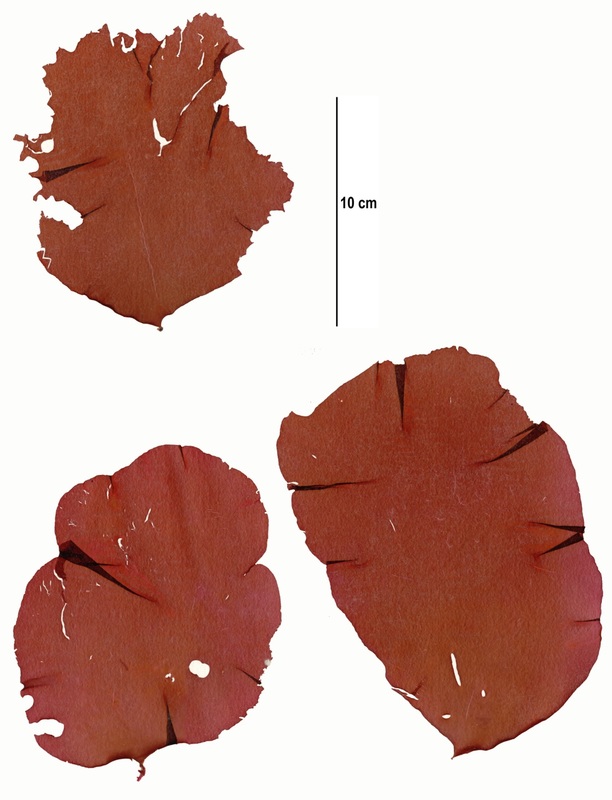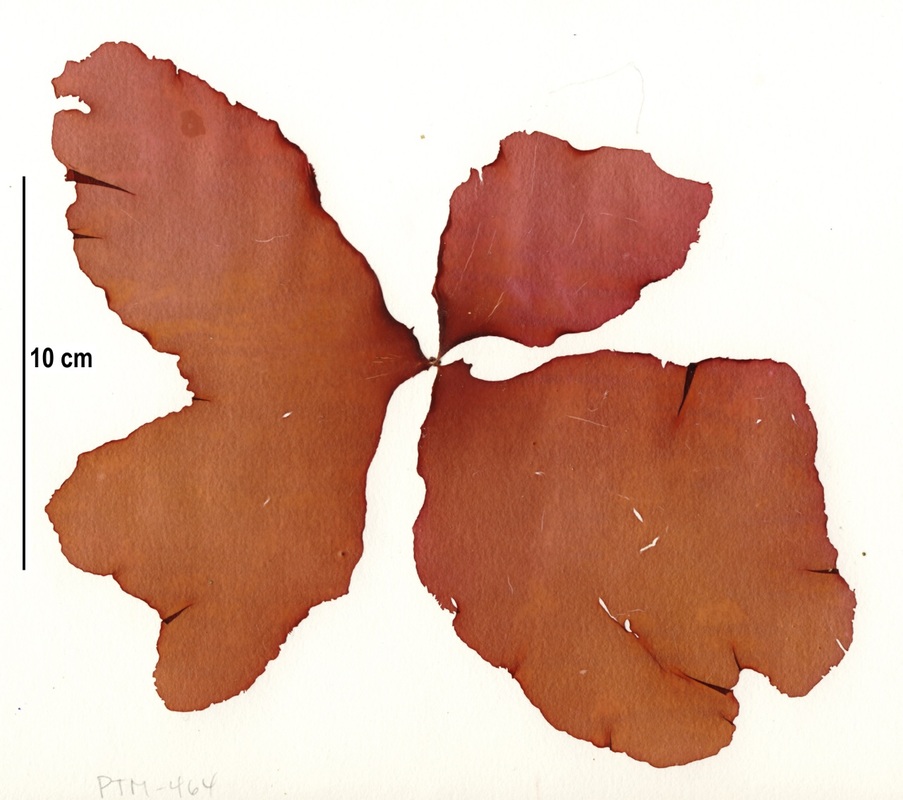Slippery red blade • Schizymenia pacifica
Specimen collection numbers PTM 408, PTM 433, and PTM 464 in the UBC Herbarium Algae Database. Search the collection numbers in the database for more information on these specimens, or search the species for further occurrences. Images courtesy of Sandra Lindstrom.
Introduction
This red alga can be identified by its unique slippery and slimy brown-red blades. Blades grow in dense clumps and are connected to a small, disc-shaped holdfast by a short stipe. Individual blades can be up to 60 cm in length, but are typically less than 30 cm. The alternate spore producing life stage of this species grows as a crust on rocks that was originally misidentified as a separate species, Haematocelis rubens.
Habitat and Range
This species is common on semi-exposed to exposed rocky shorelines. It is an annual that grows on rocks in the low intertidal and subtidal zones from the Aleutian Islands south Baja California. The photographed specimens above were collected at subtidal depths between 5 and 8 meters from beaches near the Hakai Institute on Calvert Island.
Similar Species
The shape and colour of blades of this species resemble those of Kallymeniopsis spp. However, S. pacifica can be distinguished by its slimy blades, while blades of Kallymeniopsis spp. are not slimy, and can be covered with tiny projections that give the surface a sandpaper-like texture.
Intriguing Information
Extracts from this species have been shown to inhibit reverse transcriptase activity in avian and mammalian retroviruses.
This red alga can be identified by its unique slippery and slimy brown-red blades. Blades grow in dense clumps and are connected to a small, disc-shaped holdfast by a short stipe. Individual blades can be up to 60 cm in length, but are typically less than 30 cm. The alternate spore producing life stage of this species grows as a crust on rocks that was originally misidentified as a separate species, Haematocelis rubens.
Habitat and Range
This species is common on semi-exposed to exposed rocky shorelines. It is an annual that grows on rocks in the low intertidal and subtidal zones from the Aleutian Islands south Baja California. The photographed specimens above were collected at subtidal depths between 5 and 8 meters from beaches near the Hakai Institute on Calvert Island.
Similar Species
The shape and colour of blades of this species resemble those of Kallymeniopsis spp. However, S. pacifica can be distinguished by its slimy blades, while blades of Kallymeniopsis spp. are not slimy, and can be covered with tiny projections that give the surface a sandpaper-like texture.
Intriguing Information
Extracts from this species have been shown to inhibit reverse transcriptase activity in avian and mammalian retroviruses.
References
Druehl, L. 2000. Pacific Seaweeds: A guide to common seaweeds of the west coast. Harbour Publishing: Madeira Park, BC, Canada. Pp.116
Lamb, A., and Hanby, B. (2005). Marine Life of the Pacific Northwest [electronic version]. Madeira Park, BC: Harbour Publishing.
Lindberg, M. and Lindstrom, S. (2010). Schizymenia pacifica. Seaweeds of Alaska. Accessed 2016-04-06
Nakashima, H., et al. "Antiretroviral activity in a marine red alga: reverse transcriptase inhibition by an aqueous extract of Schizymenia pacifica."Journal of cancer research and clinical oncology 113.5 (1987): 413-416.
Authors and Editors of Page
Bea Proudfoot (2016).
Druehl, L. 2000. Pacific Seaweeds: A guide to common seaweeds of the west coast. Harbour Publishing: Madeira Park, BC, Canada. Pp.116
Lamb, A., and Hanby, B. (2005). Marine Life of the Pacific Northwest [electronic version]. Madeira Park, BC: Harbour Publishing.
Lindberg, M. and Lindstrom, S. (2010). Schizymenia pacifica. Seaweeds of Alaska. Accessed 2016-04-06
Nakashima, H., et al. "Antiretroviral activity in a marine red alga: reverse transcriptase inhibition by an aqueous extract of Schizymenia pacifica."Journal of cancer research and clinical oncology 113.5 (1987): 413-416.
Authors and Editors of Page
Bea Proudfoot (2016).





